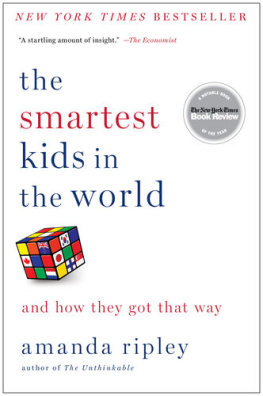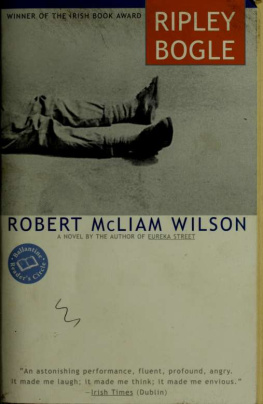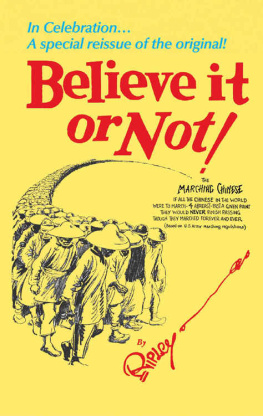also by amanda ripley
The Unthinkable: Who Survives When Disaster Strikesand Why
appendix I
how to spot a world-class education
Like most reporters, Id rather not give advice; I prefer to just relate other peoples stories and let you form your own conclusions. That is better for everyone.
And yet. Everywhere I go, parents ask me for specific action items that they can actually use in real life. They ask me at the supermarket, they ask me at the playground. Its as if they live in the real world, where prose is not all that matters.
In most countries, most parents have some choice as to where to send their children to school. It is a very hard choice, however, and useful information is shamefully hard to find. So, here is my best attempt to deliver what the people want.
Every child is different. An outstanding school for one child would be hell on earth for another. Still, when it comes to finding a school that is both rigorous and alive, full of spirit and learning, there are a few reliable questions to ask. Here is my cheat sheet to finding a world-class school based on what I have seen from visiting schools on four continents, listening to kids, teachers, and parents and studying the research of other, smarter people than myself. It is incomplete, but it is a start.
watch the students
If you are trying to understand a school, you can ignore most of the information you are given. Open houses? Pretty much useless. Spending per student? Beyond a certain baseline level, money does not translate into quality in education anywhere. The smartest countries in the world spend less per pupil than the United States.
Average class size? Not as important as most people think, except in the earliest years of schooling. In fact, the highest-performing countries typically have larger classes than the United States. The research shows that the quality of the teaching matters more than the size of the class.
Test data? More helpful, but very hard to decipher in most places. How good is the test? How much value is the school adding beyond what kids are already learning at home? More and more U.S. school districts have this kind of information, but do not make it public.
Instead, the best way to gauge the quality of a school is to spend timeeven just twenty minutesvisiting classrooms while school is in session.
When you get there, though, its important to know where to look. Parents tend to spend a lot of time staring at the bulletin boards in classrooms. Here is a better idea: Watch the students instead.
Watch for signs that all the kids are paying attention, interested in what they are doing, and working hard. Dont check for signs of order; sometimes learning happens in noisy places where the kids are working in groups without much input from the teacher. Some of the worst classrooms are quiet, tidy places that look, to adults, reassuringly calm.
Remember that rigorous learning actually looks rigorous. If the kids are whizzing through a worksheet, thats not learning. Thats filling out a form. Kids should be uncomfortable sometimes; thats okay. They should not be frustrated or despairing; instead, they should be getting help when they need it, often from each other. They should not spend long, empty stretches of time getting in line for lunch, sitting down for circle time, or handing out papers. There should be a sense of urgency that you can feel.
Resist the urge to focus on the teacher. In the best classrooms in the world, the teacher might be quiet. Or charismatic or even a tiny bit crazy (as most of us remember from our own school days). What you think of the teacher during a short visit is not as important as what the kids think after watching her all year.
I did this in every nation I visited. How interested were the students in my arrival? Engaged kids didnt take much notice; they had more important things to do. Bored kids looked back and smiled, offered a shy wave, and handed me a tissue if I sneezed. Their time was being wasted, and they were desperate for a distraction.
I saw bored kids in every country. Boredom is the specter that haunts children from kindergarten to graduation on every continent. In American classrooms, I watched a girl draw a beautiful rose tattoo on her arm with a ballpoint pen; she did it slowly, meticulously, as though she were serving a life sentence. I saw a young boy dance silently in his bright white high-tops under his desk. His upper body never moved.
In Finland, I saw a teenage boy take unusual interest in the cord of the window blinds next to him, as if it were a ripcord that might parachute him into another place. In Korea, I saw rows of students sleepingflat-out REM sleepingwith their heads upon the desks. Some had pillows. Korea was where boredom went to sleep, and got up later to study all night.
Boredom varied wildly from one classroom to the next, usually within the same school. In the best schools, though, boredom was the exception rather than the norm. You could walk into five classrooms and see just one or two students who had drifted away, mentally or physically, rather than eight or ten. Thats how you know that you are in a place of learning.
talk to the students
People, including reporters, rarely ask students for their insight. Everyone focuses on the teacher, the principal, the building, or the bulletin boards. Young kids are thought to be too small to understand; older kids are presumed to be too jaded. Neither is true, in my experience. As long as you ask intelligent questions, students are the most candid and helpful sources in any school.
Dont ask, Do you like this teacher? or Do you like your school? What if a tall, smiling stranger came to your office and asked, Do you like your boss? Youd wonder if he was a consultant brought in to fire you. Kids have the same reaction. And in any case, liking a teacher is not the same as learning from a teacher. Instead, ask questions that are specific, respectful, and meaningful.
The first thing I usually ask is straightforward: What are you doing right now? Why?
Youd be amazed how many kids can answer the first question but not the second. The second question is imperative, however. To buy into school, kids need to be reminded of the purpose all day, everyday.
In 2011, an epic Gates Foundation research study found that kids answers to specific questions were surprisingly predictive of student test-score growth and more reliable over time than classroom observations by trained observers. Tens of thousands of students of all ages were asked to agree or disagree with thirty-six different items on that particular survey (the Tripod Survey designed by Ronald Ferguson at Harvard). When you are visiting a school, you obviously cannot conduct a scientifically valid survey like this. But the questions that most correlated with student learning in that study might help shape questions that would be worth asking anyway. For example:
1. In this class, do you learn a lot every day?
2. Do students in this class usually behave the way your teacher wants them to?
3. Does this class stay busy and not waste time?
Those are the kinds of questions that studentsand only studentscan answer.
Some schools have started using variations of this same survey to help teachers improve, a smart and relatively cheap idea. If a principal or teacher uses this kind of classroom-level survey and spends significant time studying the results and learning to do better, that is a promising sign.
And heres one more question to ask students, this one supplied by Dwan Jordon, former principal of John P. Sousa Middle School in Washington, D.C.: If you dont understand something, what do you do?
In rigorous classrooms, kids know the answer.
Next page










